Deity Yoga
 In Vajrayana Buddhism there are countless deities, they are merely principles and
concepts, it is quite easy to misunderstand the images and to misinterpret the deity as
an external entity. The images of deities are actually reflections, mirror
imagess, of the nature of our own mind. Sometimes you have very
wrathful, ugly-looking, ferocious deities with lots of heads and arms;
some times they are very peaceful, beautiful and seductive. It's all a
means of trying to work on your own state of mind and your emotions,
negative emotions especially. If done incorrectly, without the proper understanding,
the practice can easily degenerate into a form of make-believe in which you are merely
pretending to be something you're not.
In Vajrayana Buddhism there are countless deities, they are merely principles and
concepts, it is quite easy to misunderstand the images and to misinterpret the deity as
an external entity. The images of deities are actually reflections, mirror
imagess, of the nature of our own mind. Sometimes you have very
wrathful, ugly-looking, ferocious deities with lots of heads and arms;
some times they are very peaceful, beautiful and seductive. It's all a
means of trying to work on your own state of mind and your emotions,
negative emotions especially. If done incorrectly, without the proper understanding,
the practice can easily degenerate into a form of make-believe in which you are merely
pretending to be something you're not.
A form of meditation used in the Tibetan tradition is visualization or deity yoga.
The meditation is a method of transforming yourself through imagination. It is like using the
result as the path. While we are still in this not-so-enlightened state, we take the enlightened
state of another being or ourselves and imagine that we are already in that state. As we
try to look, feel and think as if we were in that state, this would help you to become
what you want to be more easily. Its gradual system of stages threads each practitioner from
Theravada self-displined awareness to Mahayana compassionate awareness, to totally enlightened
awareness.
 In most religious traditions visualizing the deities as being present in front of
one, one prays to them hopefully receives their blessing. In the Vajrayana tradition,
however, the blessing, the power and the qualities of the deities are regarded as being
innate, as being within ones own mind. Through regarding oneself as the deity, defects
are gradually eradicated and good qualities gradually revealed because the potential to
transcend our problems is innate rather than external to us.
In most religious traditions visualizing the deities as being present in front of
one, one prays to them hopefully receives their blessing. In the Vajrayana tradition,
however, the blessing, the power and the qualities of the deities are regarded as being
innate, as being within ones own mind. Through regarding oneself as the deity, defects
are gradually eradicated and good qualities gradually revealed because the potential to
transcend our problems is innate rather than external to us.
Compassion in Buddhism is an active quality. Meditation on compassion
should lead to compassionate action. Here, beings that embody positive states
such as compassion are visualized and honoured in order that the qualities they represent
are born in oneself.
Some of these deities are seen as bodhisattvas, as beings capable of
generating compassion for the help of human kind. Through this
method, meditators come to realize that the qualities visualized in
the deities are within themselves. By imagining these qualities in all
their embodied force within another celestial being, it is believed
that they will grow in oneself or will be discovered within oneself.
In the Nyingmapa's tantric system (Perfection Vehicle), there is a more refined and ultimate
unification of method and system. In one's deity yoga meditation, one's ordinary aggregrate of
body and mind are dissolved into emptiness. Practitioners begin by reflecting on the empty nature
of the aggregrates of body and mind. Then they dissolve into emptiness not only their 'identity'
-the mode of being superimposed on them by ignorant mind- but also the very appearance of the ordinary
aggregrates of body and mind. Then from within that emptiness, the practitioners arises as a pure,
divine being. Taking that divine being as the focus of meditation, they then reflect again upon
its empty nature. So here within one meditatitive state of mind you find meditition on the deity's
body, combined with the apprehension of empty nature. Both deity yoga and understanding of emptiness
are complete and present within a single cognitive event of mind.
The indivisible union, in which both the factors of method and wisdom are present within a single
moment of consciousness, is common to all the tantras including the three lower(outer) classes of
tantra: Kriya, Carya, and Yoga tantra.

 In Vajrayana Buddhism there are countless deities, they are merely principles and
concepts, it is quite easy to misunderstand the images and to misinterpret the deity as
an external entity. The images of deities are actually reflections, mirror
imagess, of the nature of our own mind. Sometimes you have very
wrathful, ugly-looking, ferocious deities with lots of heads and arms;
some times they are very peaceful, beautiful and seductive. It's all a
means of trying to work on your own state of mind and your emotions,
negative emotions especially. If done incorrectly, without the proper understanding,
the practice can easily degenerate into a form of make-believe in which you are merely
pretending to be something you're not.
In Vajrayana Buddhism there are countless deities, they are merely principles and
concepts, it is quite easy to misunderstand the images and to misinterpret the deity as
an external entity. The images of deities are actually reflections, mirror
imagess, of the nature of our own mind. Sometimes you have very
wrathful, ugly-looking, ferocious deities with lots of heads and arms;
some times they are very peaceful, beautiful and seductive. It's all a
means of trying to work on your own state of mind and your emotions,
negative emotions especially. If done incorrectly, without the proper understanding,
the practice can easily degenerate into a form of make-believe in which you are merely
pretending to be something you're not. In most religious traditions visualizing the deities as being present in front of
one, one prays to them hopefully receives their blessing. In the Vajrayana tradition,
however, the blessing, the power and the qualities of the deities are regarded as being
innate, as being within ones own mind. Through regarding oneself as the deity, defects
are gradually eradicated and good qualities gradually revealed because the potential to
transcend our problems is innate rather than external to us.
In most religious traditions visualizing the deities as being present in front of
one, one prays to them hopefully receives their blessing. In the Vajrayana tradition,
however, the blessing, the power and the qualities of the deities are regarded as being
innate, as being within ones own mind. Through regarding oneself as the deity, defects
are gradually eradicated and good qualities gradually revealed because the potential to
transcend our problems is innate rather than external to us.